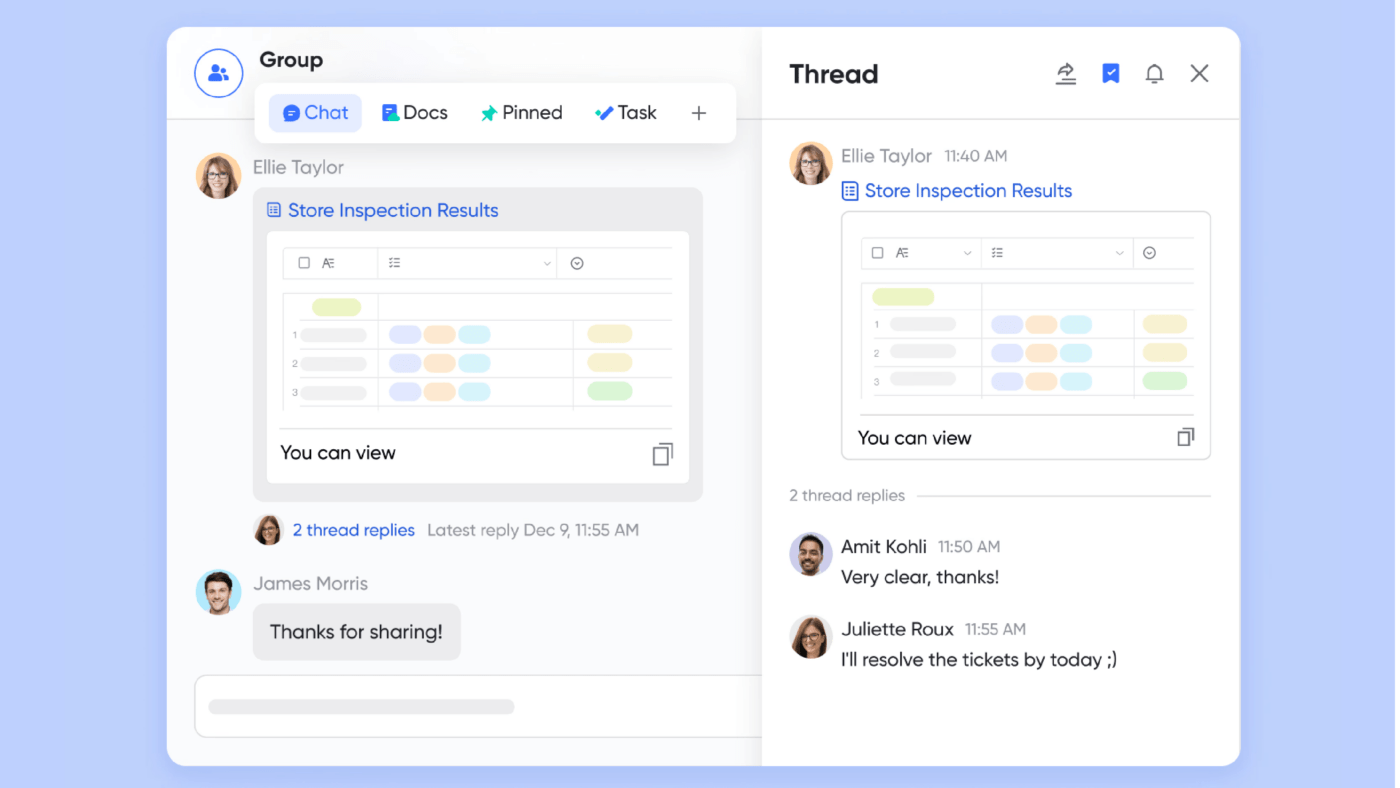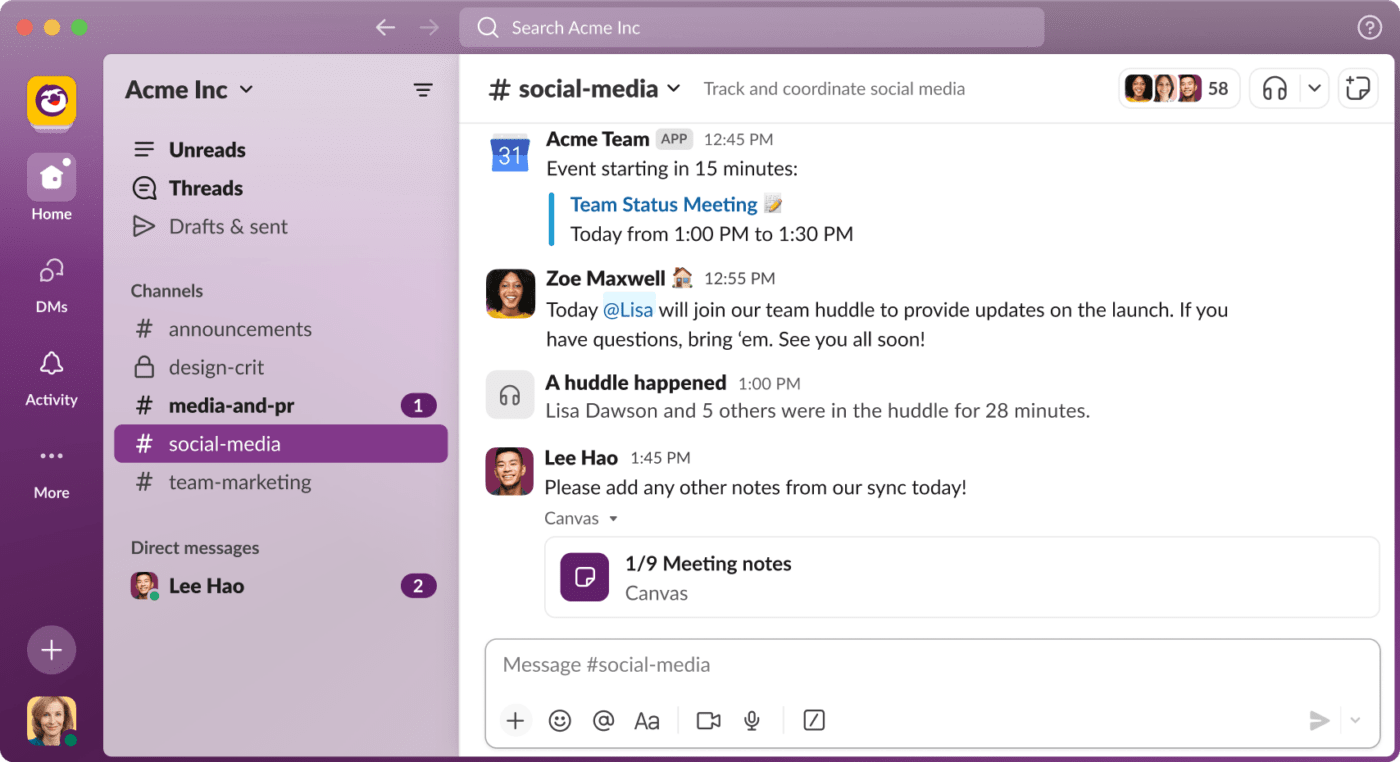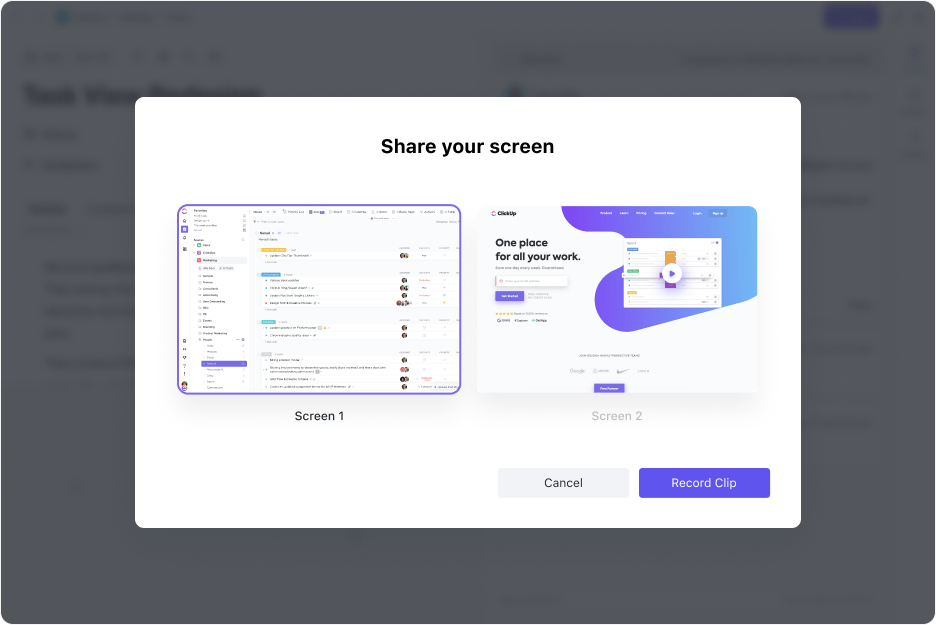

With the growth of remote work and the expansion of distributed teams, selecting the right platform can dramatically influence team dynamics.
Slack has long been a leader in business communication, known for its well-designed features and user-friendly interface. However, Lark is quickly gaining traction by offering unique capabilities that challenge the status quo.
Given their popularity, it can be tricky to make an informed choice. Thus, this blog provides a detailed guide on Lack vs. Slack to help you determine which chat app better suits your business’s evolving needs.
What Is Lark?

Lark, among the most popular new team communication apps, is a comprehensive collaboration suite designed to streamline business operations and enhance productivity across your organization. It’s a digital hub for everything—from messaging and video conferencing to task management and workflow automation.
Key features of Lark
Lark aims to improve communication and operational efficiency across all levels of your organization. Here’s a breakdown of some key features:
1. Integrated messaging system
Lark offers an integrated messaging system that supports seamless interactions across various formats—text, voice, and video.
This system allows users to create group chats, private messages, and even public forums for broader discussions. Its search functionality makes file sharing easy. Further, it makes retrieving past conversations easy and ensures no important information is lost. Additionally, it has translation capabilities, making it suitable for global teams
2. Advanced task management
Lark enhances task management by allowing users to organize tasks, set deadlines, and track progress within a unified interface. It includes other tools like the calendar for scheduling and reminders, simplifying workflows, and reducing the need for multiple platforms.
It supports tagging, prioritizing, and updating task status, promoting better team coordination and project management.
3. Comprehensive video conferencing
Lark’s video conferencing tool is a highly intuitive screen share software, offering high-definition video and audio. This makes it ideal for detailed presentations and collaborative sessions.
It provides tools for participant management, such as muting or removing attendees, making it suitable for both small and large team meetings and large webinars or educational sessions.
Lark pricing
- Starter: $0 (up to 50 users)
- Pro: $12/month per user
- Enterprise: Custom pricing
What Is Slack?

Slack is a dynamic communication platform that enhances teamwork through organized channels and integrated tools. Its main purpose is to replace traditional email with a more structured, real-time business messaging app that can scale from small teams to large enterprises.
Key features of Slack
Slack is packed with features designed to enhance productivity and collaboration. Here’s a closer look at some of its standout capabilities:
1. Channels
With Slack channels, you can streamline your team’s communication by creating dedicated spaces for different topics or projects.
This setup helps you stay organized, ensures that conversations are easy to follow, and makes important information readily accessible. Moreover, you can choose to make channels public for broader visibility or keep them private for sensitive discussions.
2. Workflow builder
Slack’s workflow builder lets teams automate routine processes directly within the platform. You can use it to design custom workflows for activities like onboarding new team members or processing requests without coding.
It simplifies your processes, reduces manual tasks, and ensures tasks are carried out consistently, boosting your team’s productivity and efficiency. This feature makes this app not just a communication tool but a versatile platform that supports basic project management workflows.
Read more: How to use Slack for project management
3. Slack Connect
With Slack Connect, take your communications beyond your organization by securely collaborating with external partners, clients, or suppliers.
This feature enables you to create shared channels between different Slack workspaces. It helps streamline your communications and ensure they remain secure and in line with your company’s policies.
Slack pricing
- Free: $0
- Pro: $8.75/month per user
- Business+: $15/month per user
- Enterprise: Custom pricing
Lark vs. Slack: Features Compared
Both Lark and Slack cater to modern businesses’ evolving needs with efficient communication and collaboration features. However, let’s compare three key features to see a detailed Lack vs. Slack comparison.
1. Integrated messaging vs. channels
Lark shines with its integrated messaging system, which supports text, voice, and video. This is crucial for global teams and includes auto-translation to minimize language barriers.
In contrast, Slack, known for its structured channels, excels in organizing conversations effectively, which is ideal for larger teams needing clear communication streams. While both platforms manage communication adeptly, Slack’s channels might edge out businesses that prioritize highly organized and searchable conversation histories.
Both platforms integrate seamlessly with popular cloud storage services like Google Drive. This enhances their file management systems and ensures that users can easily access and share documents within the chat app.
Winner: In the first round of the Lark vs. Slack comparison, Lark takes the lead for integrated messaging because it’s more adaptable and inclusive. This makes it a better choice for global, diverse teams.
2. Task management tools
In the realm of task management, Lark provides a comprehensive solution within its platform, allowing for seamless task assignments and updates. This integration is particularly useful for teams seeking an all-in-one tool to manage projects and communications together.
While Slack facilitates integrations with third-party applications, it requires additional setups, which might complicate workflow for some teams. Lark’s task management tools offer a better solution for businesses looking for built-in simplicity and efficiency.
Winner: Lark wins this round of the Lark vs. Slack face-off for its seamless, built-in task management features that simplify project management. This makes it ideal for teams that prefer everything in one place.
3. Video conferencing and external collaboration
Both platforms offer strong video conferencing features, but Lark integrates these more deeply with other productivity tools, providing a unified experience.
On the other hand, Slack has made significant strides with Slack Connect, enhancing external collaboration capabilities. Slacks Connect feature may provide a slight advantage if your business heavily engages with external stakeholders. Its ability to maintain secure, organized communications across different organizations gives you an edge.
Winner: The final round of the Lark vs. Slack comparison goes to Slack. The app excels in external collaboration with its Slack Connect feature, which provides enhanced security and organization. This is why it’s a preferred choice for businesses that regularly collaborate externally.
Lark vs. Slack on Reddit: User Perspectives
While comparing Lark vs. Slack, it’s evident that both platforms have similar features that support communication and task management. Yet, each brings unique tools to the table that may suit different business needs.
To better understand how Lack vs. Slack stacks up in the real world, we explored user discussions on Reddit. Here’s what we found from users who have extensive experience with both platforms:
One Reddit user praises Lark as a superior alternative for personal use, highlighting its productivity enhancements due to “the amount of embeds and integrations available.”
Another user shares a positive experience:
Moreover, discussions around building a CRM within Lark demonstrate its flexibility and potential to replace multiple separate tools. Users appreciate Lark’s ability to facilitate internal team communication and comprehensive task management without additional integrations.
Despite some recent frustrations with updates, Slack still garners appreciation for its core functionalities. Many users find the platform indispensable for remote work and efficient communication within tech organizations.
For instance, a user mentioned:
This highlights Slack’s strong reputation for facilitating smooth communication.
Additionally, another user expressed satisfaction with Slack’s performance and usability:
Such feedback underscores Slack’s ability to maintain a reliable and user-friendly environment that supports dynamic team interactions.
This indicates that while the update was initially disruptive, many users are finding ways to adapt and continue to appreciate Slack’s powerful features for streamlined communication and efficient workspace management.
Both Lark and Slack receive praise for different aspects of their platforms.
- Lark is lauded for its all-in-one functionality that reduces the need for multiple tools, making it ideal for users who prefer integrated solutions.
- On the other hand, Slack is still valued for its robust communication tools and its adaptability to power users willing to tweak settings to suit their workflows.
These insights highlight that both platforms have their strengths, catering to different preferences and needs within the collaboration tool space. If you’re not sure where you stand on the Lark vs. Slack question, think about what matters most to you: integration, simplicity, customization, or efficient communication tools. Your priorities in these areas will help guide your choice between the two platforms.
Meet ClickUp—The Best Alternative to Lark and Slack
ClickUp stands out as a comprehensive Lark and Slack alternative that promises to streamline how your team collaborates, plans, and executes projects. It offers a suite of features that competes with and surpasses the capabilities of Lark and Slack in many ways.
ClickUp consolidates multiple functionalities into one app, reducing the need to switch between different tools and streamlining processes.
From task management to real-time collaboration, ClickUp integrates all your work into a single platform, ensuring that nothing slips through the cracks.
Additionally, ClickUp’s customizable communication plan templates allow teams to standardize their communication strategies, ensuring consistency across all levels of interaction.
1. ClickUp’s One Up #1: Chat View

ClickUp’s Chat View redefines internal team communications by consolidating discussions right where the work happens. Unlike Lark and Slack, where chats can become siloed or disconnected from actual tasks, ClickUp Chat View integrates directly with your tasks, allowing real-time conversation in the context of actual work.
This setup keeps all relevant discussions in one place, enabling teams to transition seamlessly from chatting to doing. It eliminates the disconnect between conversations and task management, which is often the case with other apps, ensuring efficient and focused teamwork.
ClickUp’s Chat View allows you to:
- Initiate discussions linked to specific tasks
- Convert chat messages into tasks or reminders
- Track all communications related to a project in one view
2. ClickUp’s One Up #2: Clips

ClickUp’s Clips offers a dynamic way to communicate through quick video messages, allowing team members to explain complex ideas clearly and concisely.
This, in contrast to Slack’s text-heavy channels or Lark’s separate video tools, provides a more integrated and interactive approach. Clips can be created and shared within any task, chat, or document, offering a seamless experience that enhances collaboration without leaving the platform.
Clips enhance synchronous interactions and serve as an excellent asynchronous communication tool, enabling flexible, time-shifted video updates.
ClickUp’s Clips enables users to:
- Create and share quick video messages that clarify updates more effectively than text
- Share files and video updates within project threads
- Enhance remote communication with personal video messages
3. ClickUp’s One Up #3: Assign Comments

ClickUp’s Assign Comments feature allows you to assign comments, transforming casual mentions into trackable tasks. This feature is particularly advantageous over Lark and Slack, where comments can easily get lost in a sea of messages.
By allowing users to assign comments, ClickUp ensures that every piece of feedback or suggestion is tracked and accountable. This feature bridges the task management gap and significantly enhances productivity and follow-through. ClickUp’s Assign Comments feature lets you:
- Turn comments into trackable tasks
- Assign responsibility for follow-ups directly in the conversation
- Ensure accountability and visibility for every team input
Other prominent features of ClickUp
1. ClickUp Instant and Live Collaboration

ClickUp’s collaboration detection enables instant and live interactions within any task or document. Unlike Slack and Lark, which separate task management and real-time collaboration, ClickUp integrates these functionalities seamlessly.
This feature ensures that everyone on the team is on the same page without switching between apps or losing context. It supports a dynamic and synchronized work environment where changes and updates are communicated instantly across the platform.
Additionally, ClickUp enhances the mobile experience with a fully integrated app that supports all desktop functionalities. With this tool, you can:
- See team members’ activities in real time as they type or edit a shared document or whiteboard
- Collaborate on documents without delay, watching edits as they happen, with ClickUp Docs
- Receive immediate updates on any task modifications, keeping everyone informed instantly
2. ClickUp Whiteboards

ClickUp’s Whiteboards feature revolutionizes team collaboration by providing a visual platform where creativity meets execution. Ideal for brainstorming, strategic planning, and agile workflows, it enables real-time cooperation, ensuring ideas are immediately actionable.
With drawing, note-taking, and direct task-creation tools, ClickUp centralizes communication and project management in a single, intuitive interface. It lets you:
- Brainstorm and strategize in real-time
- Transform ideas into tasks directly from the whiteboard
- Enhance discussions with drawings, shapes, and notes
- Link ideas to ongoing projects for seamless integration
3. ClickUp Slack Integration
The ClickUp Slack integration transforms how teams interact and manage projects within their communication platform.

Where using Slack or Lark individually could make task management and communication feel disjointed, this integration bridges this gap by bringing detailed task management directly into Slack.
This enhances clarity, ensures workflow continuity, and significantly boosts productivity by allowing teams to manage tasks, track progress, and communicate without ever leaving Slack. Using the Slack integration, you can:
- Directly create and customize tasks in ClickUp from within Slack channels
- Link and access detailed documents related to tasks right from Slack
- Receive Slack notifications on task updates or comments in ClickUp
Why ClickUp Is the Superior Choice
As we’ve seen, ClickUp emerges as a frontrunner when compared to Lark vs. Slack, offering a more integrated and feature-rich platform than either Lark or Slack. With its top-notch task management system, real-time collaboration features, and seamless Slack integration, ClickUp provides a comprehensive solution that addresses the diverse needs of modern teams.
Whether managing projects, communicating within teams, or integrating with other tools, ClickUp simplifies and enhances every aspect of workplace productivity.
For teams looking to work smart and be productive, ClickUp is the unequivocal choice.
Ready to transform your team’s productivity and streamline your workflows?
Sign up for ClickUp today and experience a new level of organized efficiency.



